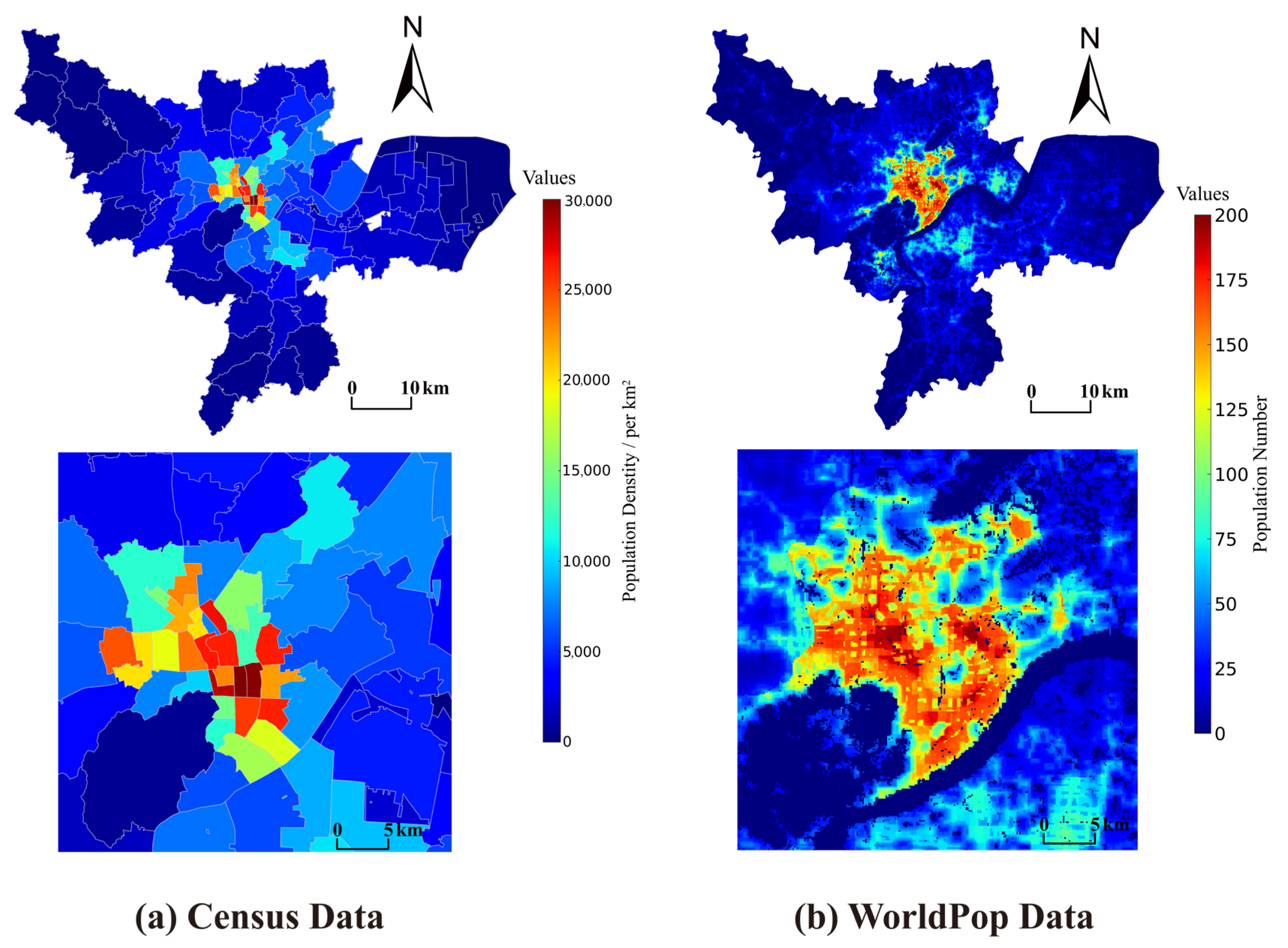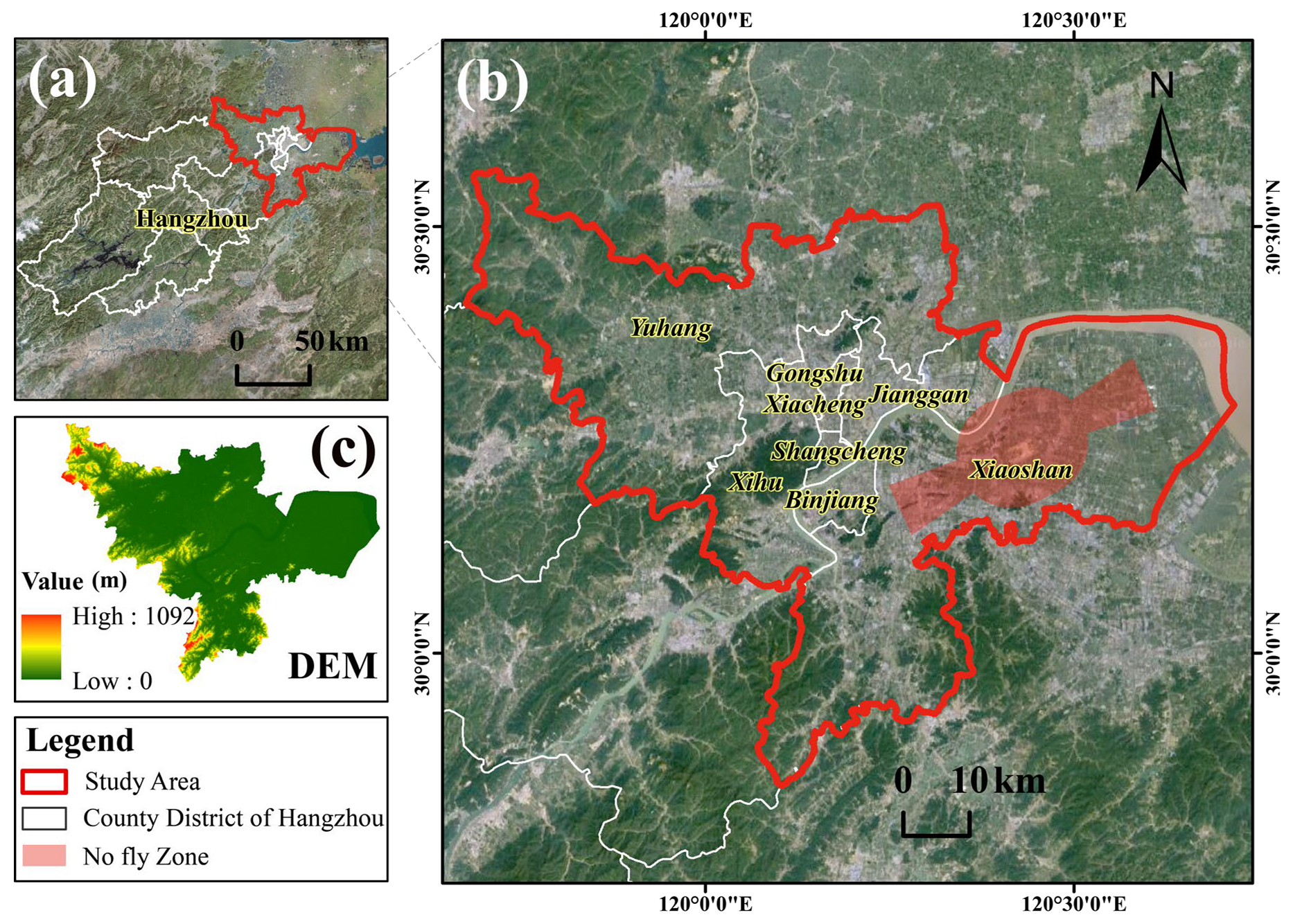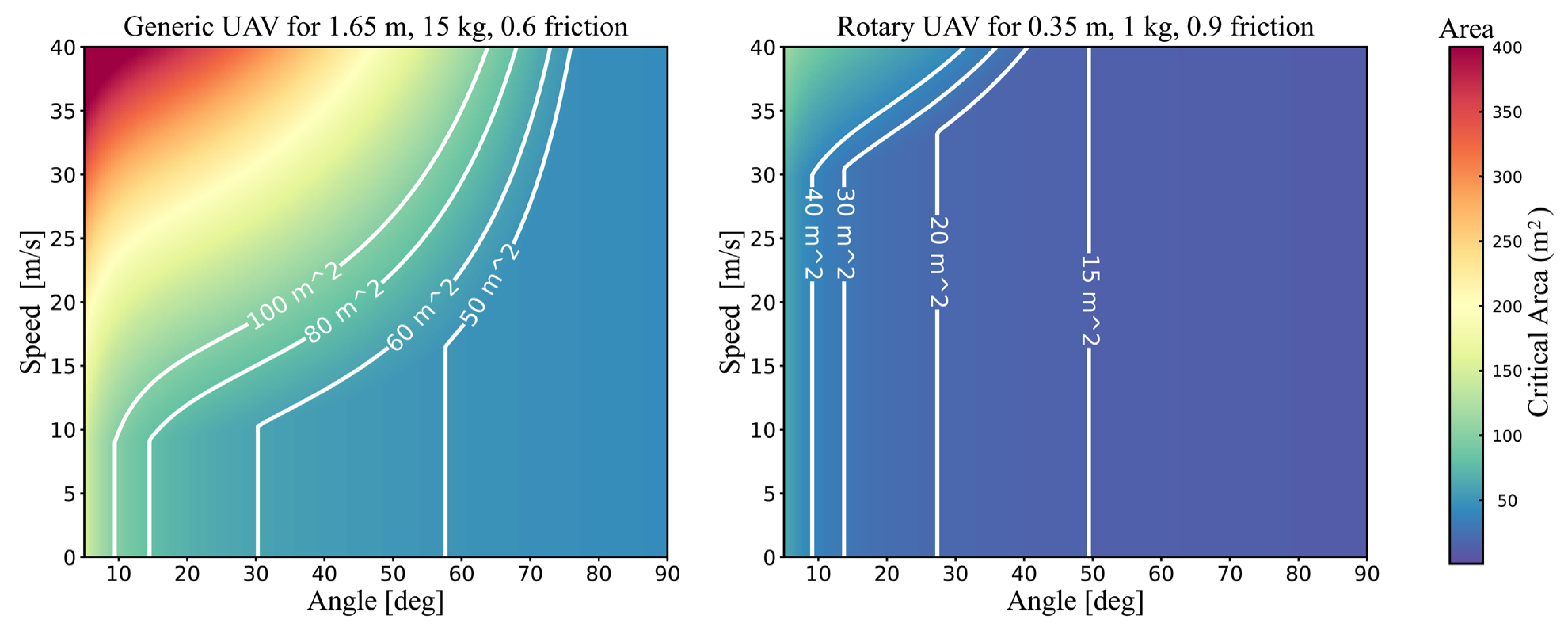Data-Driven Insights into Population Exposure Risks: Towards Sustainable and Safe Urban Airspace Utilization by Unmanned Aerial Systems
Abstract
1. Introduction
2. Materials and Methods
2.1. Study Area
2.2. Generation of Population Exposure Risk Map
2.2.1. Geographical Data

2.2.2. Data Processing for Risk Analysis

2.3. Population Exposure Risk Model
2.3.1. Number of People Exposed to the Crash
2.3.2. Probability of Fatality
2.4. Statistical Methods
3. Results
3.1. Assessing the Critical Area of UAV Crash
3.2. Population Exposure Risk Characterization
3.3. Exploring the Risk and Disparities Based on Different Spatial Units
4. Discussion
4.1. Population Exposure Risk Characterization
4.2. Model Advantages and Limitations
5. Conclusions
- (1)
- Significant variations in PER were observed among different types of UAVs operating in urban low airspace, attributable to their varying shapes, weights, and performance characteristics. In central urban areas, the average MTBF was found to be 108 orders of magnitude, indicating the need for stringent hardware and software management requirements to maintain an acceptable level of risk.
- (2)
- Spatial heterogeneity and multiscale effects were identified in the spatial pattern of PER in urban areas, consistent with the distribution of the population. Areas with high population mobility, such as transport hubs, commercial services, and residential and business areas, exhibited higher PER. Conversely, natural land uses, such as vegetation, water bodies, and croplands, generally presented lower PER levels.
- (3)
- The utilization of census units in risk assessment within urban areas presents a potential for biased estimation, particularly in regions exhibiting substantial levels of urban build-up. Specifically, higher degrees of urban build-up are prone to the underestimation of risk, whereas lower degrees can engender an overestimation. This highlights the significance of considering suitable spatial units to ensure accurate risk quantification and assessment in areas with varying levels of urban development.
Author Contributions
Funding
Data Availability Statement
Conflicts of Interest
Abbreviations
| AIS | Abbreviated Injury Scale |
| CA | Critical area |
| DEM | Digital elevation model |
| ELS | Equivalent level of safety |
| FAA | Federal Aviation Administration |
| FROM-GLC | Finer Resolution Observation and Monitoring of Global Land Cover |
| GIS | Geographic Information System |
| GPW | Gridded population of the world |
| GRM | Ground risk model |
| HIC | Head injury criterion |
| JARUS | Joint Authorities for Rulemaking on Unmanned Systems |
| MTBF | Mean time between failure |
| NTSB | National Transportation Safety Board |
| NAWCAD | Naval Air Warfare Center Aircraft Division |
| PER | Population exposure risk |
| PERM | Population exposure risk model |
| RTI | Research Triangle Institute |
| SORA | Specific Operations Risk Assessment |
| UAS | Unmanned aerial system |
| UAV | Unmanned aerial vehicle |
References
- Yao, H.; Qin, R.; Chen, X. Unmanned Aerial Vehicle for Remote Sensing Applications—A Review. Remote Sens. 2019, 11, 1443. [Google Scholar] [CrossRef]
- Rejeb, A.; Rejeb, K.; Simske, S.J.; Treiblmaier, H. Drones for supply chain management and logistics: A review and research agenda. Int. J. Logist. Res. Appl. 2023, 26, 708–731. [Google Scholar] [CrossRef]
- Floreano, D.; Wood, R.J. Science, technology and the future of small autonomous drones. Nature 2015, 521, 460–466. [Google Scholar] [CrossRef] [PubMed]
- Mohamed, N.; Al-Jaroodi, J.; Jawhar, I.; Idries, A.; Mohammed, F. Unmanned aerial vehicles applications in future smart cities. Technol. Forecast. Soc. Chang. 2020, 153, 119293. [Google Scholar] [CrossRef]
- Washington, A.; Clothier, R.A.; Silva, J. A review of unmanned aircraft system ground risk models. Prog. Aerosp. Sci. 2017, 95, 24–44. [Google Scholar] [CrossRef]
- McCarthy, T.; Pforte, L.; Burke, R. Fundamental Elements of an Urban UTM. Aerospace 2020, 7, 85. [Google Scholar] [CrossRef]
- Ma, T.; Zhou, C.H.; Pei, T.; Haynie, S.; Fan, J.F. Quantitative estimation of urbanization dynamics using time series of DMSP/OLS nighttime light data: A comparative case study from China’s cities. Remote Sens. Environ. 2012, 124, 99–107. [Google Scholar] [CrossRef]
- Zhou, G.; Li, C.; Liu, Y.; Zhang, J. Complexity of Functional Urban Spaces Evolution in Different Aspects: Based on Urban Land Use Conversion. Complexity 2020, 2020, 9741203. [Google Scholar] [CrossRef]
- Xu, C.; Liao, X.; Tan, J.; Ye, H.; Lu, H. Recent Research Progress of Unmanned Aerial Vehicle Regulation Policies and Technologies in Urban Low Altitude. IEEE Access 2020, 8, 74175–74194. [Google Scholar] [CrossRef]
- Federal Aviation Administration. System Safety Handbook; US Department of Transportation, Federal Aviation Administration: Washington, DC, USA, 2000. [Google Scholar]
- Dalamagkidis, K.; Valavanis, K.P.; Piegl, L.A. On Integrating Unmanned Aircraft Systems into the National Airspace System: Issues, Challenges, Operational Restrictions, Certification, and Recommendations, 2nd ed.; Springer Publishing Company, Incorporated: New York, NY, USA, 2013. [Google Scholar]
- Lum, C.; Waggoner, B. A Risk Based Paradigm and Model for Unmanned Aerial Systems in the National Airspace; American Institute of Aeronautics and Astronautics: Orlando, FL, USA, 2011. [Google Scholar]
- Primatesta, S.; Rizzo, A.; la Cour-Harbo, A. Ground Risk Map for Unmanned Aircraft in Urban Environments. J. Intell. Robot. Syst. 2019, 97, 489–509. [Google Scholar] [CrossRef]
- Weibel, R.; Hansman, R.J. Safety Considerations for Operation of Different Classes of UAVs in the NAS. In Proceedings of the AIAA 3rd “Unmanned Unlimited” Technical Conference, Workshop and Exhibit, Chicago, IL, USA, 20–23 September 2004. [Google Scholar]
- Zhang, X.; Liu, Y.; Zhang, Y.; Guan, X.; Delahaye, D.; Tang, L. Safety Assessment and Risk Estimation for Unmanned Aerial Vehicles Operating in National Airspace System. J. Adv. Transp. 2018, 2018, 4731585. [Google Scholar] [CrossRef]
- Joint Authorities for Rulemaking of Unmanned Systems. JARUS Guidelines on Specific Operations Risk Assessment (SORA), Public Release Edition 2.0. 2023. Available online: http://jarus-rpas.org/wp-content/uploads/2023/06/jar_09_doc_JARUS_SORA_Executive_Summary.pdf (accessed on 1 July 2023).
- Cain, S.; Torens, C.; Volkert, A.; Juchmann, P.; Tomasello, F.; Natale, M.; Vreeken, J.; Birgelen, T.v.; Ribeiro, M.; Ellerbroek, J.; et al. Standards for UAS—Acceptable Means of Compliance for Low Risk SORA Operations. In Proceedings of the AIAA Scitech 2021 Forum, Virtual, 11–15 January 2021. [Google Scholar]
- Blom, H.A.; Jiang, C.; Grimme, W.B.; Mitici, M.; Cheung, Y.S. Third party risk modelling of Unmanned Aircraft System operations, with application to parcel delivery service. Reliab. Eng. Syst. Saf. 2021, 214, 107788. [Google Scholar] [CrossRef]
- Che Man, M.H.; Haoliang, H.; Low, K.H. Crash Area Estimation for Ground Risk of Small Unmanned Aerial Vehicles Due to Propulsion System Failures. In Proceedings of the AIAA SCITECH 2022 Forum, San Diego, CA, USA, 3–7 January 2022. [Google Scholar]
- Melnyk, R.; Schrage, D.; Volovoi, V.; Jimenez, H. A third-party casualty risk model for unmanned aircraft system operations. Reliab. Eng. Syst. Saf. 2014, 124, 105–116. [Google Scholar] [CrossRef]
- Koh, C.H.; Low, K.H.; Li, L.; Zhao, Y.; Deng, C.; Tan, S.K.; Chen, Y.; Yeap, B.C.; Li, X. Weight threshold estimation of falling UAVs (Unmanned Aerial Vehicles) based on impact energy. Transp. Res. Part C Emerg. Technol. 2018, 93, 228–255. [Google Scholar] [CrossRef]
- Walker, R.; Clothier, R. Safety Risk Management of Unmanned Aircraft Systems. In Handbook of Unmanned Aerial Vehicles; Valavanis, K., Vachtsevanos, G., Eds.; Springer: Dordrecht, The Netherlands, 2015. [Google Scholar]
- Han, P.; Yang, X.; Zhao, Y.; Guan, X.; Wang, S. Quantitative Ground Risk Assessment for Urban Logistical Unmanned Aerial Vehicle (UAV) Based on Bayesian Network. Sustainability 2022, 14, 5733. [Google Scholar] [CrossRef]
- Kim, Y.; Bae, J. Risk-Based UAV Corridor Capacity Analysis above a Populated Area. Drones 2022, 6, 221. [Google Scholar] [CrossRef]
- Pang, B.; Hu, X.; Dai, W.; Low, K.H. UAV path optimization with an integrated cost assessment model considering third-party risks in metropolitan environments. Reliab. Eng. Syst. Saf. 2022, 222, 108399. [Google Scholar] [CrossRef]
- Ren, X.; Cheng, C. Model of Third-Party Risk Index for Unmanned Aerial Vehicle Delivery in Urban Environment. Sustainability 2020, 12, 8318. [Google Scholar] [CrossRef]
- Wardrop, N.A.; Jochem, W.C.; Bird, T.J.; Chamberlain, H.R.; Clarke, D.; Kerr, D.; Bengtsson, L.; Juran, S.; Seaman, V.; Tatem, A.J. Spatially disaggregated population estimates in the absence of national population and housing census data. Proc. Natl. Acad. Sci. USA 2018, 115, 3529–3537. [Google Scholar] [CrossRef]
- Yao, Y.; Liu, X.; Li, X.; Zhang, J.; Liang, Z.; Mai, K.; Zhang, Y. Mapping fine-scale population distributions at the building level by integrating multisource geospatial big data. Int. J. Geogr. Inf. Sci. 2017, 31, 1220–1244. [Google Scholar] [CrossRef]
- Gong, P.; Chen, B.; Li, X.; Liu, H.; Wang, J.; Bai, Y.; Chen, J.; Chen, X.; Fang, L.; Feng, S.; et al. Mapping essential urban land use categories in China (EULUC-China): Preliminary results for 2018. Sci. Bull. 2020, 65, 182–187. [Google Scholar] [CrossRef]
- Leyk, S.; Gaughan, A.E.; Adamo, S.B.; de Sherbinin, A.; Balk, D.; Freire, S.; Rose, A.; Stevens, F.R.; Blankespoor, B.; Frye, C.; et al. The spatial allocation of population: A review of large-scale gridded population data products and their fitness for use. Earth Syst. Sci. Data 2019, 11, 1385–1409. [Google Scholar] [CrossRef]
- Doxsey-Whitfield, E.; MacManus, K.; Adamo, S.B.; Pistolesi, L.; Squires, J.; Borkovska, O.; Baptista, S.R. Taking Advantage of the Improved Availability of Census Data: A First Look at the Gridded Population of the World, Version 4. Pap. Appl. Geogr. 2015, 1, 226–234. [Google Scholar] [CrossRef]
- Bright, E.A.; Coleman, P.R.; Dobson, J.E. LandScan: A Global Population Database for Estimating Populations at Risk. Photogramm. Eng. Remote Sens. 2000, 66, 849–858. [Google Scholar]
- Tatem, A.J. WorldPop, open data for spatial demography. Sci. Data 2017, 4, 170004. [Google Scholar] [CrossRef] [PubMed]
- Zhu, W.; Chen, J. The spatial analysis of digital economy and urban development: A case study in Hangzhou, China. Cities 2022, 123, 103563. [Google Scholar] [CrossRef]
- Xu, C.; Liao, X.; Fei, Y. IEEE Standard Pioneered an It-Led Interdisciplinary Approach to Structure Low-Altitude Airspace for Uav Operations. Sci. China Inf. Sci. 2022, 65, 207201. [Google Scholar] [CrossRef]
- Su, Y.; Xu, Y. Risk-Based Flight Planning and Management for Urban Air Mobility. In AIAA AVIATION 2022 Forum; American Institute of Aeronautics and Astronautics: Chicago, IL, USA, 2022. [Google Scholar] [CrossRef]
- Tan, M.; Li, X.; Li, S.; Xin, L.; Wang, X.; Li, Q.; Li, W.; Li, Y.; Xiang, W. Modeling population density based on nighttime light images and land use data in China. Appl. Geogr. 2018, 90, 239–247. [Google Scholar] [CrossRef]
- Montgomery, R.M. Casualty Areas from Impacting Inert Debris for People in the Open; Research Triangle Institute: Research Triangle Park, NC, USA, 1995. [Google Scholar]
- Ball, J.A.; Knott, M.; Burke, D. Crash Lethality Model; Naval Air Warfare Center Aircraft Division: Patuxent River, MD, USA, 2012. [Google Scholar]
- Associate Administrator for Commercial Space Transportation. Flight Safety Analysis Handbook. 2011. Available online: https://www.faa.gov/about/office_org/headquarters_offices/ast/media/Flight_Safety_Analysis_Handbook_final_9_2011v1.pdf (accessed on 1 July 2023).
- Range Commanders Council Range Safety Group Risk Committee. Common Risk Criteria Standards for National Test Ranges: Supplement; US Army White Sands Missile Range: White Sands Missile Range, NM, USA, 2007. [Google Scholar]
- Tepylo, N.; Straubinger, A.; Laliberte, J. Public perception of advanced aviation technologies: A review and roadmap to acceptance. Prog. Aerosp. Sci. 2023, 138, 100899. [Google Scholar] [CrossRef]








| Land Cover Type | Population Density Weight 1 | Sheltering Factor 1 |
|---|---|---|
| Cropland | 0.02 | 0.5 |
| Forest | 0.03 | 1.5 |
| Grassland | 0.02 | 0.5 |
| Shrubland | 0.02 | 0.8 |
| Wetland | 0.01 | 0.2 |
| Water | 0.02 | 0.2 |
| Imperious area 2—outdoor | 0.3 | 0.3 |
| Imperious area 2—indoor | 0.5 | 4 |
| Bare land | 0.03 | 0.2 |
| Type | Name | Wingspan (mm) | Length (mm) | MTOM (kg) | Speed (m/s) |
|---|---|---|---|---|---|
| Generic | ZhihangV330 | 3300 | 1650 | 15 | 25 |
| Rotary | DJI Phantom 4 Pro | 350 | 350 | 1.375 | 20 |
Disclaimer/Publisher’s Note: The statements, opinions and data contained in all publications are solely those of the individual author(s) and contributor(s) and not of MDPI and/or the editor(s). MDPI and/or the editor(s) disclaim responsibility for any injury to people or property resulting from any ideas, methods, instructions or products referred to in the content. |
© 2023 by the authors. Licensee MDPI, Basel, Switzerland. This article is an open access article distributed under the terms and conditions of the Creative Commons Attribution (CC BY) license (https://creativecommons.org/licenses/by/4.0/).
Share and Cite
He, H.; Liao, X.; Ye, H.; Xu, C.; Yue, H. Data-Driven Insights into Population Exposure Risks: Towards Sustainable and Safe Urban Airspace Utilization by Unmanned Aerial Systems. Sustainability 2023, 15, 12247. https://doi.org/10.3390/su151612247
He H, Liao X, Ye H, Xu C, Yue H. Data-Driven Insights into Population Exposure Risks: Towards Sustainable and Safe Urban Airspace Utilization by Unmanned Aerial Systems. Sustainability. 2023; 15(16):12247. https://doi.org/10.3390/su151612247
Chicago/Turabian StyleHe, Hongbo, Xiaohan Liao, Huping Ye, Chenchen Xu, and Huanyin Yue. 2023. "Data-Driven Insights into Population Exposure Risks: Towards Sustainable and Safe Urban Airspace Utilization by Unmanned Aerial Systems" Sustainability 15, no. 16: 12247. https://doi.org/10.3390/su151612247
APA StyleHe, H., Liao, X., Ye, H., Xu, C., & Yue, H. (2023). Data-Driven Insights into Population Exposure Risks: Towards Sustainable and Safe Urban Airspace Utilization by Unmanned Aerial Systems. Sustainability, 15(16), 12247. https://doi.org/10.3390/su151612247









